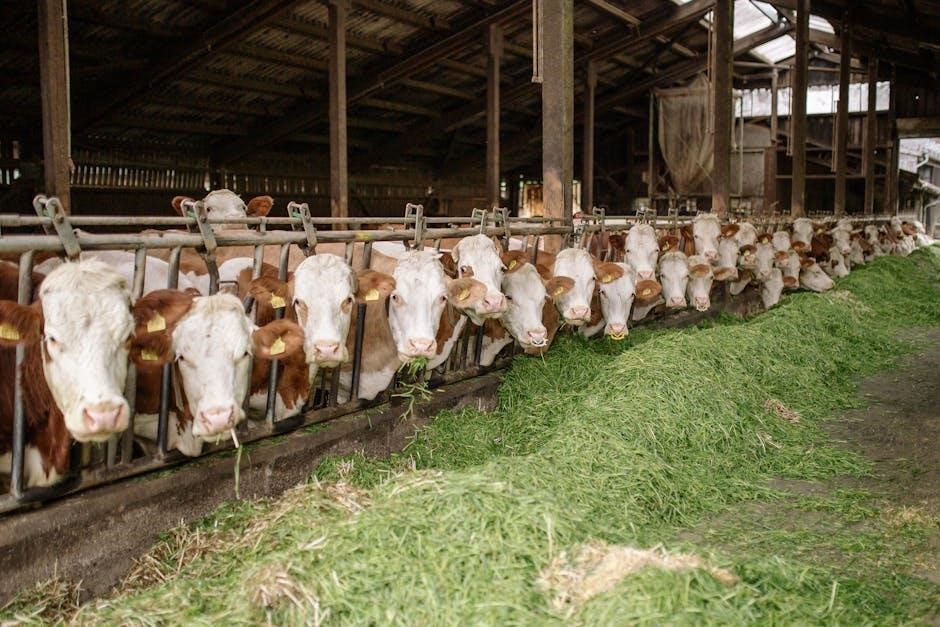The Fox Farm feeding schedule is a comprehensive guide for optimizing plant nutrition, ensuring healthy growth and maximizing yields. It outlines the use of key products like Big Bloom, Grow Big, and Tiger Bloom at specific stages, providing detailed feeding charts and application frequencies. This schedule is designed to help growers of all levels achieve the best results by following a structured nutrient plan tailored to their plants’ needs.
1.1 Importance of Proper Feeding for Healthy Plant Growth
Proper feeding is crucial for healthy plant growth, ensuring balanced nutrient intake and preventing deficiencies or overloads. A well-structured feeding schedule like Fox Farm’s supports robust root development, vibrant foliage, and abundant blooms. It helps maintain optimal pH and PPM levels, avoiding nutrient lockout and stress. By following a balanced nutrient plan, growers can maximize yields and ensure their plants thrive at every growth stage.
1.2 Overview of Fox Farm Nutrient Products
Fox Farm offers a range of nutrient products tailored for plant growth, including Big Bloom, Grow Big, and Tiger Bloom. These formulas provide essential macronutrients and micronutrients, promoting healthy plant development. Additional products like Kelp Me Kelp and Beastie Bloom enhance specific growth stages. Their Dirty Dozen line is a popular choice among growers, offering a complete fertilizer solution. These products are designed to support robust growth and maximize yields when used according to the feeding schedule.

Understanding the Fox Farm Feeding Schedule
The Fox Farm feeding schedule is a structured guide for applying nutrients, ensuring optimal plant growth and high yields by providing clear instructions on timing and application.
2.1 Key Components of the Feeding Schedule
The Fox Farm feeding schedule includes three main products: Big Bloom, Grow Big, and Tiger Bloom. Each serves a specific purpose, with Big Bloom promoting overall health, Grow Big enhancing foliage, and Tiger Bloom boosting flowering; The schedule also specifies application rates, frequency, and pH/EC management, ensuring balanced nutrition and preventing over-fertilization. Proper timing and dosage are emphasized to optimize growth stages from seedling to harvest, fostering robust plants and higher yields.

2.2 How to Read and Interpret the Feeding Chart
The Fox Farm feeding chart is structured as a table with columns representing growth stages (seedling, vegetative, flowering) and rows listing products like Big Bloom and Grow Big. Each cell specifies the recommended dosage in teaspoons or milliliters per gallon of water. Understanding the chart requires noting the weeks of growth and corresponding product measurements. Color-coded sections or symbols may highlight key phases or transitions, ensuring accurate application. Always refer to the chart for precise timing and amounts to avoid under- or over-fertilizing.

Feeding Schedule for Different Growth Stages
The Fox Farm feeding schedule is tailored to meet plants’ nutritional needs during seedling, vegetative, and flowering phases, ensuring optimal growth and yield through stage-specific nutrient application.

3.1 Seedlings and Cuttings
For seedlings and cuttings, the Fox Farm feeding schedule recommends starting with Big Bloom at 6 teaspoons per gallon of water. Feed every other watering to avoid over-fertilization. Seedlings typically don’t require nutrients until they develop their first set of leaves. This gentle approach supports root development and prevents stress. Avoid mixing multiple products early on, as this can overwhelm young plants. Stick to the recommended dosage to ensure healthy establishment before transitioning to the vegetative phase.
3.2 Vegetative Phase
During the vegetative phase, plants require consistent nutrient intake to develop strong foliage and root systems. The Fox Farm schedule suggests using Grow Big at increasing dosages, starting with 4 teaspoons per gallon and gradually increasing to 6 teaspoons. Feed every other watering, alternating with pure water to prevent over-fertilization. Continue using Big Bloom at 2 teaspoons per gallon once a week for micronutrient support. This balanced approach promotes healthy leaf growth and prepares plants for the flowering phase.
3.3 Flowering Phase
The flowering phase focuses on promoting bud development and maximizing yields. Switch from Grow Big to Tiger Bloom, starting with 4 teaspoons per gallon and increasing to 8 teaspoons as buds mature. Continue using Big Bloom at 2 teaspoons per gallon once a week for micronutrient support. Feed every other watering, alternating with pure water to avoid over-fertilization. Monitor runoff PPM levels, aiming to maintain around 1200-1400 during this stage. This balanced approach ensures robust flower growth and optimal yield potential.
Application Frequency and Dosage
Feed every other watering, using 2 tsp of Big Bloom, 4 tsp of Grow Big, and 8 tsp of Tiger Bloom per gallon. Follow the chart.
4.1 Frequency of Feeding
The Fox Farm feeding schedule recommends feeding every other watering to avoid overloading the soil. For seedlings, start with once a week, gradually increasing to twice weekly during the vegetative phase. During flowering, maintain consistent feeding to support bud development. Always check the PPM levels in runoff water to ensure optimal nutrient uptake and adjust feeding frequency accordingly.
4.2 Recommended Dosages for Each Product
Start with half the recommended dosage to avoid stressing plants. For Big Bloom, use 6 tsp per gallon for seedlings and cuttings. Grow Big is applied at 10 tsp per gallon during the vegetative phase, increasing to full strength as plants mature. Tiger Bloom is introduced in the flowering phase at 8 tsp per gallon. Always feed every other watering and monitor PPM levels, adjusting as needed to maintain optimal nutrient balance. Follow the schedule closely for best results.
pH and EC Management
Maintaining optimal pH levels (5.6–6.8) and monitoring EC/PPM ensures nutrient availability and prevents lockout. Regularly test runoff water and adjust as needed to avoid overloading the soil with nutrients.
5;1 Maintaining Optimal pH Levels
Maintaining optimal pH levels is crucial for nutrient availability and plant health. Fox Farm recommends keeping the pH between 5.6 and 6.8 for most crops. Regularly test the soil or runoff water after feeding to ensure pH stability. If the pH is too high or low, adjust it using pH-balancing products. Consistent monitoring prevents nutrient lockout and ensures plants absorb essential nutrients efficiently, promoting robust growth and preventing stress-related issues.
5.2 Monitoring and Adjusting EC/PPM Levels
Monitoring EC/PPM levels ensures optimal nutrient uptake without overloading the soil. Fox Farm’s feeding schedule suggests maintaining EC levels around 2.4 during flowering and 800-1200 PPM for soil; Regularly test runoff water to gauge nutrient concentration. Adjust feeding amounts if levels are too high or low. Proper balance prevents nutrient burn and ensures plants receive the right amount of food for healthy growth and maximum yield.

Fox Farm Product Line Overview
Fox Farm offers a comprehensive range of nutrient products tailored for plant growth, including Big Bloom, Grow Big, and Tiger Bloom, designed to support healthy plant development.
6.1 Big Bloom, Grow Big, and Tiger Bloom
These core Fox Farm products are specifically formulated to support plant growth at different stages. Big Bloom promotes robust flowering, while Grow Big enhances vegetative growth. Tiger Bloom is introduced during the flowering phase to boost blooming. Each product has designated application rates, ensuring balanced nutrient delivery. Proper timing and dosage, as per the feeding schedule, maximize their effectiveness, helping growers achieve optimal plant health and productivity throughout the growth cycle.
6.2 Additional Products and Their Roles
Beyond the trio, Fox Farm offers supplementary products like Kelp Me Kelp You and Beastie Bloomz, which enhance plant vitality and fruit development. These additives provide micronutrients and organic matter, supporting overall plant health. They are integrated into the feeding schedule to address specific growth needs, ensuring a holistic approach to plant nutrition. Proper use of these products complements the core fertilizers, promoting robust growth and maximizing yields effectively.

Troubleshooting Common Issues
Common issues include nutrient deficiencies, overfeeding, and pH imbalances. Yellowing leaves or wilted plants may indicate improper feeding or pH levels. Regular monitoring prevents such problems.
7.1 Signs of Nutrient Deficiency or Overload
Identifying nutrient-related issues is crucial for plant health. Nutrient deficiency may cause yellowing leaves, stunted growth, or purpling stems, while overload can lead to tip burn, curled leaves, or dark discoloration. If plants show unusual stress or color changes, check the feeding schedule and soil pH. Overfeeding with products like Big Bloom or Grow Big can cause toxicity, so monitor runoff PPM levels regularly to ensure balanced nutrition and prevent damage.
7.2 How to Flush and Reset the Soil
When signs of nutrient overload occur, flushing the soil is essential to restore plant health. Start by watering the soil thoroughly with pH-balanced water, ensuring no added nutrients. For coco-based media, flush every two weeks as part of routine maintenance. If using soil like Happy Frog, flush when runoff PPM drops below 800. This process leaches excess salts, preventing root damage and allowing plants to recover. Repeat if necessary to completely reset the soil profile.
Maximizing Yield Potential
Maximizing yield involves consistent feeding, combining Fox Farm products, and maintaining optimal pH/EC levels as per the feeding chart for robust plant growth and higher outputs.
8.1 Combining Different Fox Farm Products
Combining Fox Farm products like Big Bloom, Grow Big, and Tiger Bloom is key for balanced nutrition. Start with Big Bloom for seedlings, then transition to Grow Big during the vegetative phase to promote leaf growth. Introduce Tiger Bloom in flowering to boost bud development. Always follow the recommended ratios on the feeding chart to avoid over-fertilization, ensuring each nutrient complements the plant’s growth stage for optimal results and maximum yield potential.
8.2 Timing and Consistency in Feeding
Timing and consistency are crucial for maximizing plant growth. Follow the feeding chart to ensure nutrients are applied at the right stages. Feed every other watering, starting with half the recommended dosage to avoid over-fertilization. Monitor runoff PPM levels, adjusting as needed to maintain optimal ranges. Consistent application ensures steady nutrient availability, promoting healthy growth and preventing deficiencies or burn. Adjust timing based on plant response and growth phase for best results.
Adhering to the Fox Farm feeding schedule ensures optimal plant health and maximizes yields. Proper timing, dosage, and monitoring are key to achieving successful growth and flowering stages consistently.
9.1 Summary of Best Practices
Follow the Fox Farm feeding chart closely, adjusting for plant stage and growth media. Monitor pH (5.6–6.8) and EC levels, avoiding overfeeding. Start with half the recommended dosage, gradually increasing as plants respond. Avoid mixing concentrated nutrients; add to water separately. Flush soil if stress or nutrient overload occurs. Consistency and patience are key to maximizing yields and ensuring healthy plant development throughout the growing cycle.
9.2 Final Tips for Success with Fox Farm Feeding Schedule
Consistency and patience are key to achieving optimal results. Always monitor pH and EC levels, ensuring they stay within the recommended range. Start with half the suggested dosage to avoid nutrient burn. Regularly check runoff PPM levels and adjust feeding accordingly. Flush the soil if signs of stress or over-fertilization appear. Follow the feeding chart diligently and tailor it to your plants’ specific needs for a thriving and productive grow cycle.